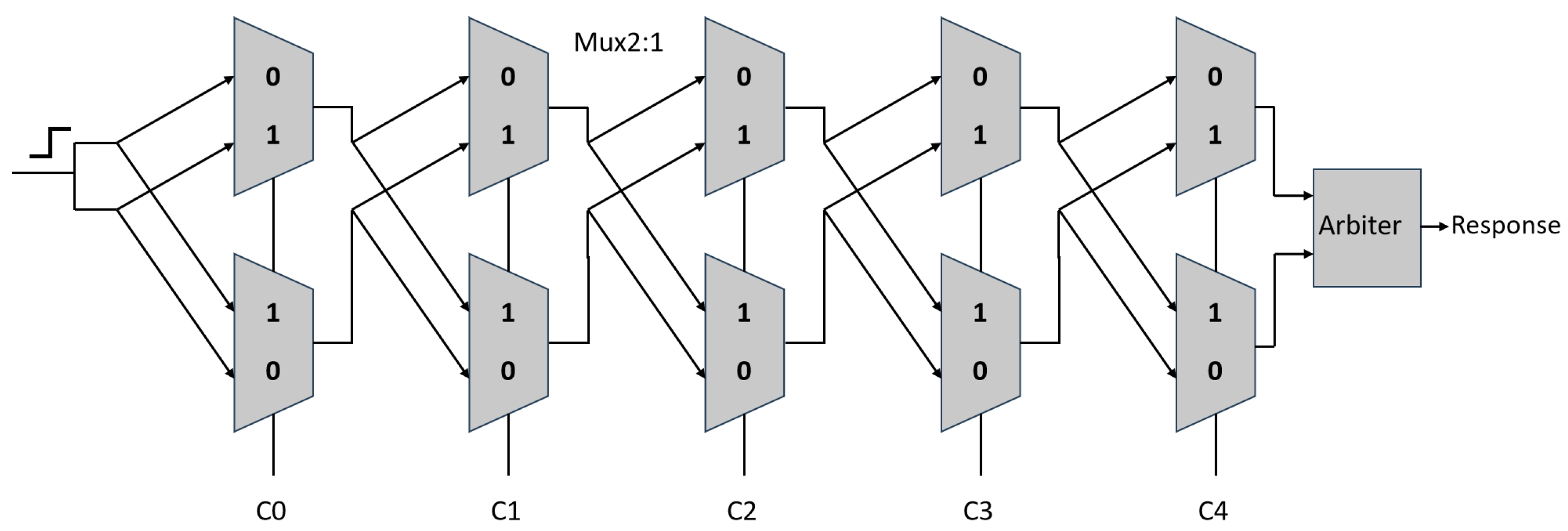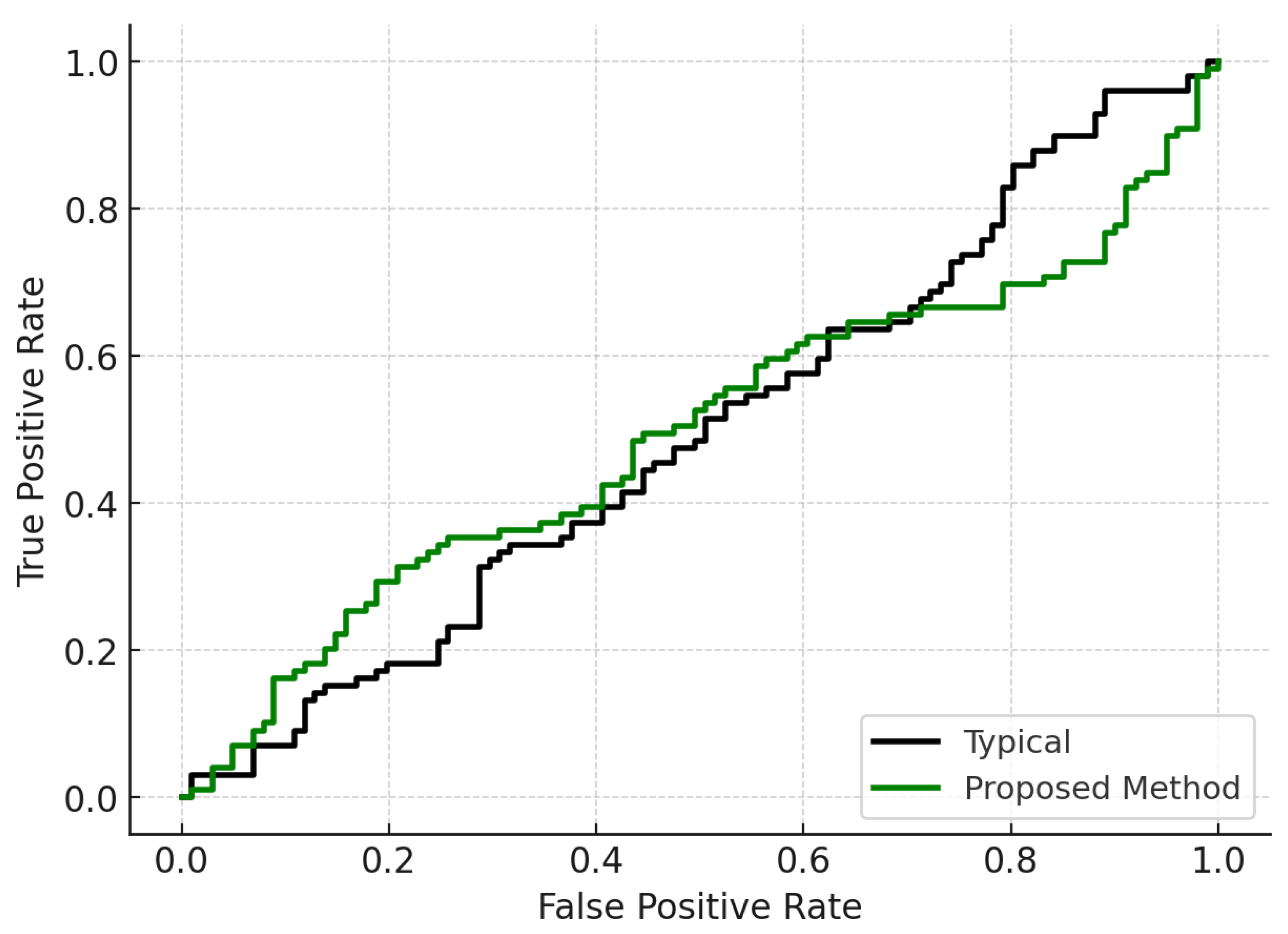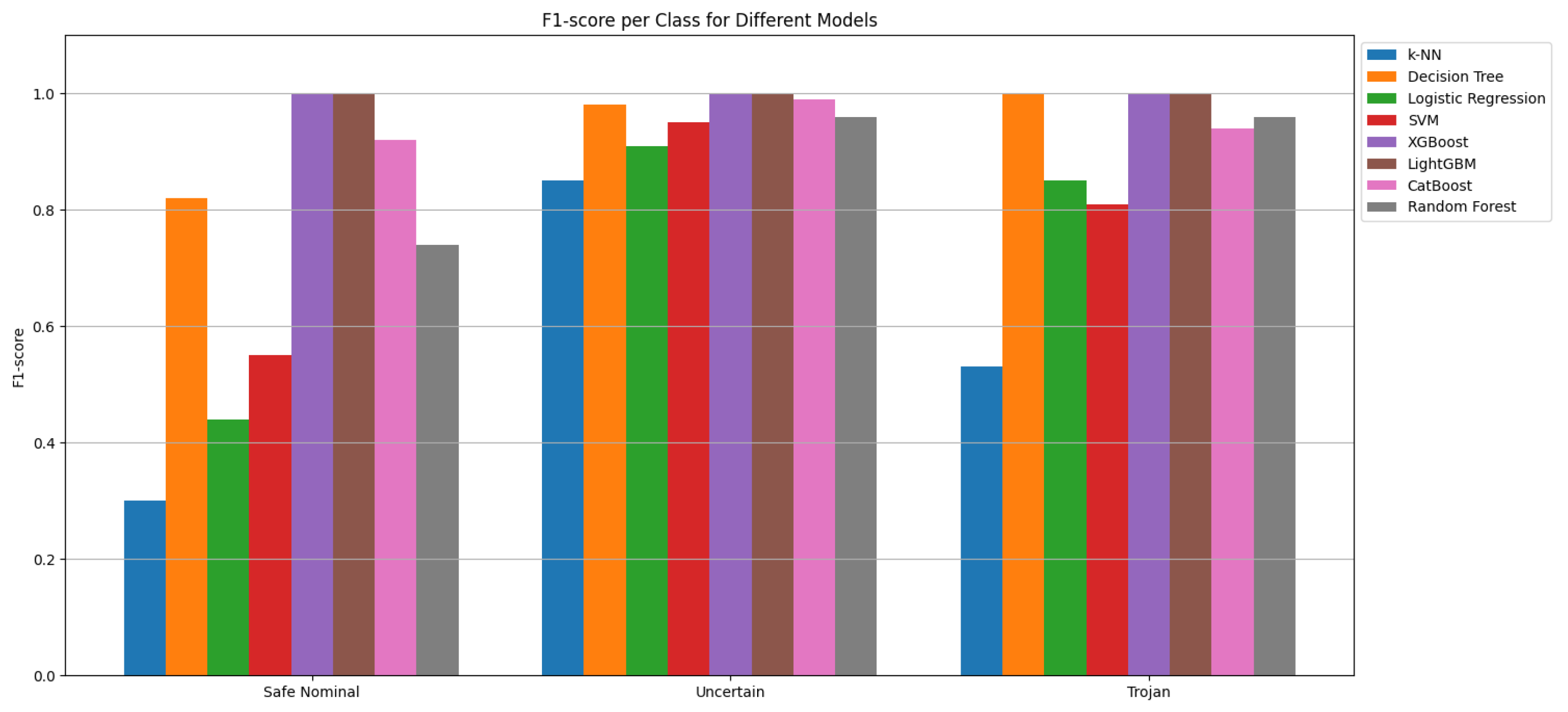Triggered Hardware Trojan Detection in IP Cores for Ensuring Safety in Cyber Physical Systems
Abstract
1. Introduction
- A trigger-aware side-channel feature extraction from IP cores leveraging power and timing and applying machine learning models explicitly designed to detect Trojan activation under rare triggers.
- Cryptographic IP core integrity checks through PUF sensors for tamper resistance, which delivers dynamic mitigation using partial FPGA reconfiguration to isolate compromised modules.
2. Related Work
3. Proposed Methodology
3.1. Side-Channel Data Acquisition
3.2. Trigger-Aware Test Pattern Generation
| Algorithm 1 Trigger-aware test pattern generation |
| Require: Netlist , number of TDPs , toggle threshold , baseline TDP set Ensure: Refined pattern set
|
3.3. Machine Learning-Based Trojan Detection
- (alpha): Activity factor, randomly sampled within the range of –.
- f (frequency): Switching frequency, randomly sampled between and .
- C (capacitance): Derived from the dynamic power relation: , where P is the partition power and V is the fixed supply voltage (1.2 V).
- V (voltage): Fixed at 1.2 V for all computations.
3.4. PUF Sensors for Correlation
4. Results and Discussion
4.1. Machine Learning-Based Classification
4.2. PUF Correlation and Overhead
4.3. Comparison
5. Conclusions
Author Contributions
Funding
Institutional Review Board Statement
Informed Consent Statement
Data Availability Statement
Conflicts of Interest
References
- Kacmarcik, A.; Prvulovic, M. Securing CPS Through Simultaneous Analog Side-Channel Monitoring of Cyber and Physical Domains. IEEE Access 2024, 12, 126717–126728. [Google Scholar] [CrossRef]
- Pandey, A.K.; Zeadally, S.; Das, A.K.; Kumar, N. Secure Integration of Cyber Engineering and Medical Cyber-Physical System: A Survey and Open Issues. ACM Comput. Surv. 2025, 12, 1–36. [Google Scholar] [CrossRef]
- Xiang, Y. Physical Attack Methods in Cyber-Physical Systems: Hardware Trojan Attacks and Ultrasonic Phased Array Tracking. Ph.D. Thesis, University of California, Irvine, CA, USA, 2025. [Google Scholar]
- Hayashi, V.T.; Ruggiero, W.V. Hardware trojan detection in open-source hardware designs using machine learning. IEEE Access 2025, 13, 37771–37788. [Google Scholar] [CrossRef]
- Hazari, N.A.; Oun, A.; Niamat, M. Machine Learning Vulnerability Analysis of FPGA-Based Ring Oscillator PUFs and Counter Measures. ACM J. Emerg. Technol. Comput. Syst. 2021, 17, 1–20. [Google Scholar] [CrossRef]
- Sun, P.; Halak, B.; Kazmierski, T.J. Towards Hardware Trojan Resilient Convolutional Neural Network Accelerators. J. Hardw. Syst. Secur. 2025, 1–8. [Google Scholar] [CrossRef]
- Ahmed, I.F.; Hossain, F.S. Glitch Variability Aware Power Side-Channel for Detecting Hardware Trojans. In Proceedings of the 2024 International Conference on Advances in Computing, Communication, Electrical, and Smart Systems (iCACCESS), Dhaka, Bangladesh, 8–9 March 2024; pp. 1–6. [Google Scholar]
- Miah, A.; Hossain, F.S. CRO-PUF: Resilience to Machine Learning and Differential Power Attacks. Comput. Secur. 2025, 151, 104313. [Google Scholar] [CrossRef]
- Dang, T.K.; Nguyen, K.D.; Hoang, T.T.; Pham, C.K. A Unified Approach to Strong PUF and TRNG Using Ring Generator for Cryptography. IEEE Internet Things J. 2025, 12, 36590–36603. [Google Scholar] [CrossRef]
- Wang, L.; Wu, L.; Zhang, Z.; Zhang, X.; Zhou, J. A hardware Trojan detection method based on sensor chains for post-quantum classic McEliece circuits. In Proceedings of the International Conference on Informatics, Networking, and Computing, Wuhan, China, 25–27 October 2024; Volume 13078, pp. 251–258. [Google Scholar]
- Huang, D.-C.; Hsiao, C.-F.; Chang, T.-W.; Chu, Y.-Y. A security method of hardware Trojan detection using path tracking algorithm. EURASIP J. Wirel. Commun. Netw. 2022, 2022, 81. [Google Scholar] [CrossRef]
- Tantawy, A.; Abdelwahed, S.; Erradi, A.; Shaban, K. Model-based risk assessment for cyber physical systems security. Comput. Secur. 2020, 96, 101864. [Google Scholar] [CrossRef]
- Pimple, J.F.; Sharma, A.; Mishra, J.K. Elevating Security Measures in Cyber-Physical Systems: Deep Neural Network-Based Anomaly Detection with Ethereum Blockchain for Enhanced Data Integrity. J. Electr. Syst. 2023, 19, 105. [Google Scholar] [CrossRef]
- Saraf, M.; Syed, T.H.; Kulkarni, A.; Niamat, M. Hardware Trojan Detection Employing Machine Learning, Physical Unclonable Functions and Side Channel Analysis. In Proceedings of the 2024 IEEE International Conference on Electro Information Technology (eIT), Eau Claire, WI, USA, 30 May–1 June 2024; pp. 514–519. [Google Scholar]
- Worley, K.; Rahman, M.T. Supervised machine learning techniques for Trojan detection with ring oscillator network. In Proceedings of the IEEE SoutheastCon, Huntsville, AL, USA, 11–14 April 2019; pp. 1–7. [Google Scholar]
- Hasegawa, K.; Yanagisawa, M.; Togawa, N. Trojan-net classification for gate-level hardware design utilizing boundary net structures. IEICE Trans. Inf. Syst. 2020, 103, 1618–1622. [Google Scholar] [CrossRef]
- Elnour, M.; Meskin, N.; Khan, K.; Jain, R. A dual-isolation-forests-based attack detection framework for industrial control systems. IEEE Access 2020, 8, 36639–36651. [Google Scholar] [CrossRef]
- Ravikumar, G.; Hyder, B.; Govindarasu, M. Hardware-in-the-loop CPS security architecture for DER monitoring and control applications. In Proceedings of the 2020 IEEE Texas Power and Energy Conference (TPEC), College Station, TX, USA, 6–7 February 2020; pp. 1–5. [Google Scholar]
- Gonzalez-Granadillo, G.; Diaz, R.; Caubet, J.; Garcia-Milà, I. CLAP: A cross-layer analytic platform for the correlation of cyber and physical security events affecting water critical infrastructures. J. Cybersecur. Priv. 2021, 1, 365–386. [Google Scholar] [CrossRef]
- Abdo, H.; Kaouk, M.; Flaus, J.-M.; Masse, F. A safety/security risk analysis approach of Industrial Control Systems: A cyber bowtie—combining new version of attack tree with bowtie analysis. Comput. Secur. 2018, 72, 175–195. [Google Scholar] [CrossRef]
- Noorizadeh, M.; Shakerpour, M.; Meskin, N.; Unal, D.; Khorasani, K. A cyber-security methodology for a cyber-physical industrial control system testbed. IEEE Access 2021, 9, 16239–16253. [Google Scholar] [CrossRef]
- Hossain, F.S.; Seum, A.; Chowdhury, M.R.Z.; Ahmed, F. ZDD: A Zero Delay Deviation Variability-Aware Golden Free Hardware Trojan Detection Using Physical Unclonable Function. IEEE Trans. Circuits Syst. I Regul. Pap. 2025, 72, 4153–4166. [Google Scholar] [CrossRef]
- Hossain, F.S.; Yuneda, T. An exquisitely sensitive variant-conscious post-silicon Hardware Trojan detection. Integration 2023, 93, 102064. [Google Scholar] [CrossRef]
- Pang, Z.; Zhang, J.; Zhou, Q.; Gong, S.; Qian, X.; Tang, B. Crossover ring oscillator PUF. In Proceedings of the 2017 18th International Symposium on Quality Electronic Design (ISQED), Santa Clara, CA, USA, 14–15 March 2017; pp. 237–243. [Google Scholar]
- Seum, A.; Chowdhury, M.R.; Hossain, F.S. An Efficient Machine Learning Approach for Hardware Trojan Detection. In Proceedings of the 2022 25th International Conference on Computer and Information Technology (ICCIT), Cox’s Bazar, Bangladesh, 17–19 December 2022; pp. 182–187. [Google Scholar]
- Trust-Hub Consortium. Chip-Level Hardware Trojan Benchmarks. Online. 2025. Available online: https://trust-hub.org/#/benchmarks/chip-level-trojan (accessed on 2 September 2025).
- Jiang, Z.; Ding, Q. A Framework for Hardware Trojan Detection Based on Contrastive Learning. Sci. Rep. 2024, 14, 30847. [Google Scholar] [CrossRef] [PubMed]








| Benchmark | Baseline Toggle (%) | Proposed (%) |
|---|---|---|
| AES-128 | 6.3 | 14.8 |
| RS323 | 5.9 | 15.2 |
| Benchmark | Typical TDP | Proposed | Improvement (%) |
|---|---|---|---|
| AES-128 (T100) | 85.4% | 95.7% | +12.1% |
| AES-128 (T200) | 82.8% | 94.1% | +13.6% |
| RS323 (T300) | 83.6% | 93.2% | +11.5% |
| RS323 (T400) | 80.2% | 91.8% | +14.5% |
| Average | 82.98% | 93.7% | +12.6% |
| ML Model | Precision | Recall | F1-Score |
|---|---|---|---|
| Random Forest | 96.5% | 94% | 94% |
| Logistic Regression | 89.8% | 88% | 89% |
| XGBoost | 100% | 100% | 100% |
| CatBoost | 96.5% | 95% | 95% |
| K-NN | 79% | 73% | 76% |
| Decision Tree | 98.3% | 97% | 97% |
| SVM | 91.2% | 91% | 91% |
| LightGBM | 100% | 100% | 100% |
| Metric | AES-128 | RS323 | Average |
|---|---|---|---|
| LUT Overhead (%) | 2.9 | 2.4 | 2.65 |
| Detection Latency (ms) | 4.8 | 5.1 | 4.95 |
| Ref. | Trigger Activation Strategy | Side-Channel Modality | Learning Setup | PUF Use | Overhead | Contribution & Limitations |
|---|---|---|---|---|---|---|
| [23] | Rare signal | Power and delay | – | No | 0.221% (AES-128) | Improved detection sensitivity of 99.98%; consider the process variations |
| [27] | No, generic stimulation | Power | Contrastive supervised | No | No | Improves quality but timing is not leveraged |
| [22] | Yes | Power and delay | – | CRO-PUF | 4.19% (AES-128), FPGA | Improved detection sensitivity of 93.90%; consider the process variations |
| [14] | Generic patterns | Power | Classical ML | Yes (authentication/verification) | No | Demonstrates feasibility of combining ML, SCA, and PUF; lacks rare net targeting and runtime reconfiguration. |
| [25] | Yes, triggering by TDPs | Power and delay | Classical ML | Yes (improved stability) | No | Enhances PUF Detection sensitivity by 99.75%; process variation effect may reduces detection rate |
| [5] | No | Power | ML attacks on PUFs | Yes (target) | Not measured | 78% sensitivity of detection and motivates cross check thresholds and robust enrollment |
| Proposed | Trigger-aware TDP refinement with rare net | Power and timing | Temporal and classical ML | RO-PUF with cross validation | 2.9% (AES-128), FPGA | 100% detection accuracy and double-mode cross checking for robust security |
Disclaimer/Publisher’s Note: The statements, opinions and data contained in all publications are solely those of the individual author(s) and contributor(s) and not of MDPI and/or the editor(s). MDPI and/or the editor(s) disclaim responsibility for any injury to people or property resulting from any ideas, methods, instructions or products referred to in the content. |
© 2025 by the authors. Licensee MDPI, Basel, Switzerland. This article is an open access article distributed under the terms and conditions of the Creative Commons Attribution (CC BY) license (https://creativecommons.org/licenses/by/4.0/).
Share and Cite
Talukder, M.R.; Alam, M.E.; Fahim, A.M.M.; Hossain, F.S. Triggered Hardware Trojan Detection in IP Cores for Ensuring Safety in Cyber Physical Systems. Chips 2025, 4, 47. https://doi.org/10.3390/chips4040047
Talukder MR, Alam ME, Fahim AMM, Hossain FS. Triggered Hardware Trojan Detection in IP Cores for Ensuring Safety in Cyber Physical Systems. Chips. 2025; 4(4):47. https://doi.org/10.3390/chips4040047
Chicago/Turabian StyleTalukder, Mahfuzur Rahman, Md. Eftekhar Alam, Abu Monsur Mohammah Fahim, and Fakir Sharif Hossain. 2025. "Triggered Hardware Trojan Detection in IP Cores for Ensuring Safety in Cyber Physical Systems" Chips 4, no. 4: 47. https://doi.org/10.3390/chips4040047
APA StyleTalukder, M. R., Alam, M. E., Fahim, A. M. M., & Hossain, F. S. (2025). Triggered Hardware Trojan Detection in IP Cores for Ensuring Safety in Cyber Physical Systems. Chips, 4(4), 47. https://doi.org/10.3390/chips4040047






